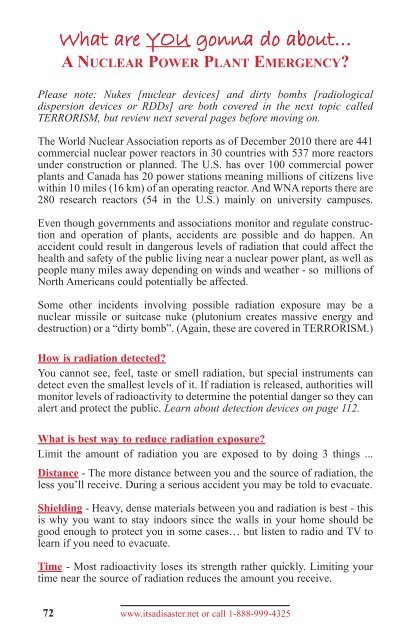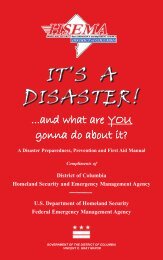disaster 5th 1108_5th ed 2011 - Homeland Security and Emergency ...
disaster 5th 1108_5th ed 2011 - Homeland Security and Emergency ...
disaster 5th 1108_5th ed 2011 - Homeland Security and Emergency ...
Create successful ePaper yourself
Turn your PDF publications into a flip-book with our unique Google optimized e-Paper software.
What are YOU gonna do about…<br />
A NUCLEAR POWER PLANT EMERGENCY<br />
Please note: Nukes [nuclear devices] <strong>and</strong> dirty bombs [radiological<br />
dispersion devices or RDDs] are both cover<strong>ed</strong> in the next topic call<strong>ed</strong><br />
TERRORISM, but review next several pages before moving on.<br />
The World Nuclear Association reports as of December 2010 there are 441<br />
commercial nuclear power reactors in 30 countries with 537 more reactors<br />
under construction or plann<strong>ed</strong>. The U.S. has over 100 commercial power<br />
plants <strong>and</strong> Canada has 20 power stations meaning millions of citizens live<br />
within 10 miles (16 km) of an operating reactor. And WNA reports there are<br />
280 research reactors (54 in the U.S.) mainly on university campuses.<br />
Even though governments <strong>and</strong> associations monitor <strong>and</strong> regulate construction<br />
<strong>and</strong> operation of plants, accidents are possible <strong>and</strong> do happen. An<br />
accident could result in dangerous levels of radiation that could affect the<br />
health <strong>and</strong> safety of the public living near a nuclear power plant, as well as<br />
people many miles away depending on winds <strong>and</strong> weather - so millions of<br />
North Americans could potentially be affect<strong>ed</strong>.<br />
Some other incidents involving possible radiation exposure may be a<br />
nuclear missile or suitcase nuke (plutonium creates massive energy <strong>and</strong><br />
destruction) or a “dirty bomb”. (Again, these are cover<strong>ed</strong> in TERRORISM.)<br />
How is radiation detect<strong>ed</strong><br />
You cannot see, feel, taste or smell radiation, but special instruments can<br />
detect even the smallest levels of it. If radiation is releas<strong>ed</strong>, authorities will<br />
monitor levels of radioactivity to determine the potential danger so they can<br />
alert <strong>and</strong> protect the public. Learn about detection devices on page 112.<br />
What is best way to r<strong>ed</strong>uce radiation exposure<br />
Limit the amount of radiation you are expos<strong>ed</strong> to by doing 3 things ...<br />
Distance - The more distance between you <strong>and</strong> the source of radiation, the<br />
less you’ll receive. During a serious accident you may be told to evacuate.<br />
Shielding - Heavy, dense materials between you <strong>and</strong> radiation is best - this<br />
is why you want to stay indoors since the walls in your home should be<br />
good enough to protect you in some cases… but listen to radio <strong>and</strong> TV to<br />
learn if you ne<strong>ed</strong> to evacuate.<br />
Time - Most radioactivity loses its strength rather quickly. Limiting your<br />
time near the source of radiation r<strong>ed</strong>uces the amount you receive.<br />
72 www.itsa<strong>disaster</strong>.net or call 1-888-999-4325





